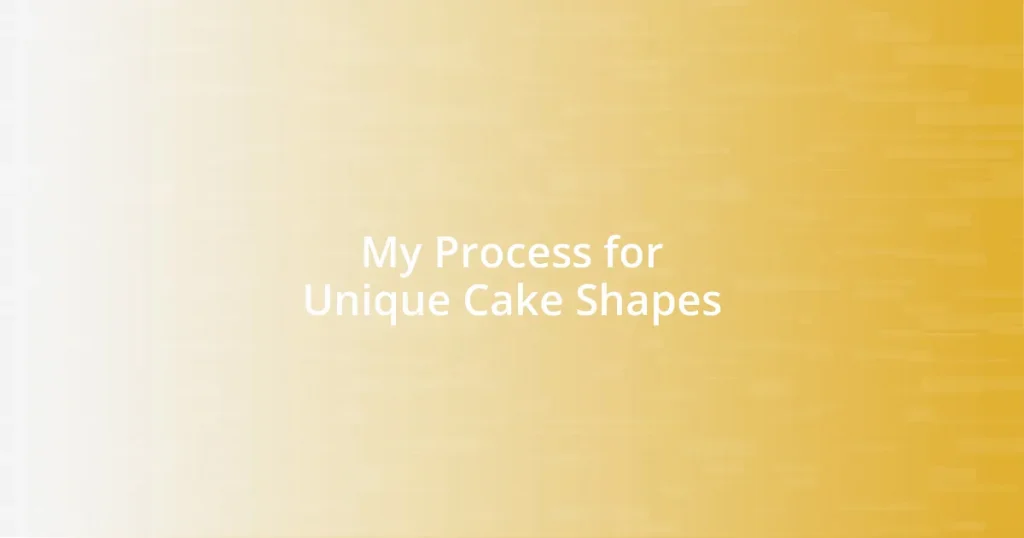Key takeaways:
- Unique cake shapes can evoke emotions and memories, transforming celebrations into extraordinary experiences.
- Choosing a denser cake recipe enhances sculpting and supports intricate designs; moisture balance and flavor pairing are also crucial.
- Essential tools like a cake leveler, serrated knife, and offset spatula are critical for achieving professional-looking cake shapes.
- Final presentation matters; elements like lighting and backdrop can elevate the cake’s visual appeal and ambiance of the event.

Understanding Unique Cake Shapes
When I first started experimenting with unique cake shapes, it was like unlocking a new level in my baking journey. I remember crafting a two-tiered cake shaped like a teapot for a friend’s bridal shower; the joy on her face was priceless. Each unique shape not only captures the eye but also tells a story, doesn’t it?
Unique cake shapes can indeed transform an ordinary celebration into something extraordinary. They’re a fun way to express personal connections and memories. For instance, I once made a cake shaped like a favorite childhood toy for a birthday party, and the nostalgia it evoked among the guests was overwhelming. Have you ever thought about how a cake can not only satisfy a sweet tooth but also stir emotions and memories?
Understanding the intricacies of crafting these shapes is essential for any baker aspiring to stand out. The geometry of cakes can be quite fascinating—who knew that what we often overlook in the kitchen could be so mathematically engaging? I find that combining flavors with visual elements creates an experience that lingers long after the last slice has been served. Isn’t it wonderful to think of how a simple cake can bring joy, make people smile, and inspire conversations?

Choosing the Right Cake Recipe
Choosing the right cake recipe is crucial when you’re embarking on the journey of creating unique cake shapes. I still recall the first time I attempted to make a eight-layer cake designed to look like a towering castle. The recipe I chose was a classic vanilla buttercream which held its structure beautifully, allowing me to stack and carve with confidence. Opting for denser cake recipes can often be a game changer; they lend themselves better to sculpting and holding intricate designs.
Here are some key points to consider when selecting your cake recipe:
- Density Matters: Heavier cakes like pound cake or carrot cake are often ideal for sculpting.
- Moisture Level: A good balance of moisture prevents the cake from crumbling, essential for complex shapes.
- Flavor Pairing: Choose flavors that will complement the aesthetics of your design, enhancing the overall experience.
- Allergen Considerations: If your audience has dietary restrictions, consider gluten-free or vegan options without compromising texture.
- Practice Batch: I always bake a test cake to ensure my chosen recipe meets my expectations before the final design.
Remember, the right recipe sets the foundation not just for the cake’s appearance, but also for its taste and texture, which is equally important in captivating your audience.

Essential Tools for Cake Shaping
Selecting the essential tools for cake shaping is as critical as the recipe itself. I’ve found that having the right equipment can make all the difference in achieving those eye-catching designs. From my own experience, a simple serrated knife has often transformed what could have been a lopsided creation into a masterpiece. Not only does it slice through the cake with ease, but it also helps me achieve smooth, clean edges—something I learned after a few stressful attempts with a dull knife.
When diving into cake shaping, certain tools quickly become my go-to favorites. A cake leveler has saved me countless hours of frustration, ensuring each layer is perfectly even. I also highly recommend investing in a good set of offset spatulas; they’re ideal for spreading frosting smoothly, hiding any imperfections. In my early days, I took the spatula for granted, but now I appreciate how it gives my cakes that polished, professional finish.
Here’s a quick comparison of the essential tools to have on hand:
| Tool | Function |
|---|---|
| Cake Leveler | Evenly slice cake layers |
| Serrated Knife | Trim and carve shapes |
| Offset Spatula | Spread frosting smoothly |
| Bench Scraper | Achieve sharp edges and patterns |
| Balloon Whisk | Incorporate air for light, fluffy textures |

Techniques for Shaping Cakes
When it comes to shaping cakes, there’s an element of artistry at play that I find deeply satisfying. One technique I adore is the “carving” method, where you take a cooled cake and use a serrated knife to sculpt it into your desired form. I remember the first time I shaped a cake into the silhouette of a mermaid. It was exhilarating to see the layers transform, and I was amazed at how a little patience could yield such beautiful results.
Another approach I often utilize is the “stenciling” technique. By placing a stencil over my cake and dusting it with powdered sugar or cocoa powder, I create intricate designs without the hassle of detailed piping. There’s something magical about unveiling that perfect pattern underneath the dust. I still smile when I recall my daughter’s birthday cake, which featured stars and moons—such a simple yet effective way to add flair!
Don’t overlook the power of mold shaping either! Silicone molds are handy for creating unique decorations like flowers or abstract shapes. I once used a mold to craft delicate roses for a wedding cake, and the joy on the couple’s faces when they saw those tiny details was unforgettable. It reinforces my belief that even the smallest elements can elevate a cake from ordinary to extraordinary. Which technique resonates most with you? Have you ever tried one of these methods, and what did you create?

Decorating Unique Cake Shapes
When it comes to decorating unique cake shapes, I love playing with colors and textures to truly bring a design to life. One technique I often embrace is using fondant, which allows for smooth surfaces that can be molded into nearly any shape. There’s something incredibly satisfying about rolling out sheets of fondant, then applying them to my creations. I still remember the first time I wrapped a fondant-covered cake; it felt like I was draping fabric on a masterpiece, making an otherwise simple cake look fantastically lavish.
As I decorate, I often experiment with edible glitter and gold leaf. The first time I added a sprinkle of edible glitter to a whimsical cupcake tower, I was surprised by how much a little shimmer could elevate the entire presentation. It’s as if these tiny details have the power to cast a spell, turning a cake from just a dessert into a show-stopping centerpiece. Have you ever noticed how a touch of sparkle makes everything feel more special?
Another approach I find myself using often is incorporating fresh flowers and fruits as decorations. A vibrant array of fresh berries atop a rustic, shaped cake creates a lovely contrast, almost like nature’s jewels. I recall vividly the joy I felt when my niece’s cake was adorned with a cascade of fresh peonies; the combination of their softness against the cake’s firm surface created a stunning visual symphony. How do you think the addition of natural elements changes the overall feel of a cake? In my experience, it transforms the dessert into a celebration of nature and beauty, making each bite feel more intentional and memorable.

Tips for Final Presentation
When it comes to the final presentation of my cakes, I believe that placement is everything. I often take a step back and visualize the entire setting—what colors will complement each other? For instance, during my best friend’s wedding, I chose a stunning glass cake stand that lifted the cake and allowed the delicate lace design I had created to shine. Have you ever noticed how a cake can command the room simply through its presentation?
Lighting plays a crucial role in showcasing my creations. When I set up a dessert table, I always incorporate soft, ambient lighting. The glow can make a cake shimmer, enhancing its textures and colors. I remember displaying a chocolate ganache cake at a party, and when the lights dimmed, the surface gleamed like rich velvet. It became the centerpiece everyone gravitated towards, prompting me to think about how different lighting can influence the mood of any occasion.
Finally, don’t underestimate the power of a well-chosen backdrop. Whether it’s a bold-colored tablecloth or a simple rustic wood board, the backdrop can enhance the beauty of the cake. I once used a sunlit window as my backdrop for a spring-themed cake, allowing the natural light to filter through and highlight every detail. It was captivating! As you think about your cake’s final presentation, what backdrop do you envision that could elevate your creation?















